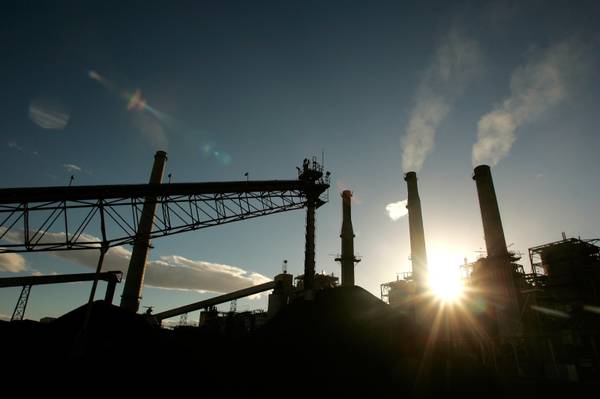President Barack Obama sought to mark his legacy on Monday with an ambitious rule that would roll back greenhouse-gas emissions with regulations that curb emissions from power plants, the largest source of carbon pollution.
And while the rule is expected to face considerable opposition, with attorneys general preparing legal challenges and Republican Senate Majority Leader Mitch McConnell sending pre-emptive letters urging all 50 governors to not comply with the Environmental Protection Agency’s plan, many elected officials and environmental advocates cheered the news.
Standing in front of the solar arrays that line Las Vegas City Hall, city officials and leaders in clean energy held a rally in support of the rule. Las Vegas City Councilman Steve Ross called it “a great day.”
“I support the state in its creation of a robust, smart, clean power plan to both reduce carbon pollution from existing power plants and allow Nevada to increase its reliance on homegrown clean energy,” Ross said, who also urged individuals to cut personal carbon use.
Nevada is said to have the greatest possibilities for solar generation of any state and the third-most potential for geothermal generation, so a greater push toward renewables across the nation could expand an export market for renewables, a likely stimulus for the state’s economy.
“Because of our boundless solar and geothermal, it puts Nevada in a great position to be an exporter of energy to our neighboring states as part of the definition of the regional energy market,” Jennifer Taylor, executive director of the Clean Energy Project, said.
Not everyone cheered the announcement. U.S. Rep. Joe Heck, R-Nev., released a statement saying that although he sees potential for renewable growth in the state, he believes that fossil fuels remain an important industry for energy and jobs. "To maintain our economic and national security, we must maximize all of our nation's energy resources, including renewable sources, alternative fuels, and fossil fuels, all in a way that balances economic development and protecting our environment,” he said. "This plan is not the all-of-the-above energy strategy needed to boost job creation and reduce energy prices for families.”
Under the final Environmental Protection Agency rule, which administration officials say incorporated 4 million public comments and hundreds of meetings, each state is required to develop a plan for reducing power-plant emissions and received individualized goals from the EPA. Nevada’s goal is to reduce its power plant emissions rate from a historical 2012 baseline rate of 1,102 pounds of carbon dioxide per net megawatt hour to 855 by 2030.
The state will be asked to cut its emission less than it otherwise would have been after the EPA changed its methodology in the final rule. Paul Thomsen, director of the Nevada Office of Energy, said that although the rate is less stringent than the one that the EPA issued in its draft proposal, his office in collaboration with other state agencies will need to review the changes before developing a plan. “We really need to dig into the detail of the final rule to understand where those changes came from,” he said.
Compared to other states, the EPA considers the Nevada reductions to be more stringent. However, a spokesperson for NV Energy said that it expects to be able to comply with the regulations without an increase in customer rates.
At the press conference, supporters of the rule said the state is well on track to implement the EPA regulations, having shifted away from coal-fired plants in a 2013 bipartisan legislative effort. Last year, NV Energy, the state’s regulated utility, closed three of its four coal-generated units at Reid Gardner Power Plant near Moapa and plans to close the fourth unit in 2017. And with tax breaks to renewable energy projects, the state has seen more than $5.5 billion in private development of renewables and leads in per capita solar jobs.
A statement from the White House Monday applauded Nevada for already taking steps to reduce its power-sector carbon footprint by 14 percent since 2008 and a commitment to produce 25 percent of its electricity from renewable sources by 2025.
Nevada U.S. Sen. Harry Reid, the Democratic minority leader, echoed this sentiment Monday. “Nevada is well-positioned to continue building its clean energy economy under the Clean Power Plan,” Reid said in a press release. “States like Nevada will have the flexibility to tailor our own programs for reducing carbon emissions, while protecting public health, and keeping electricity affordable and reliable.”
According to the U.S. Energy Information Administration, as of April 2015, about 72 percent of Nevada’s electricity generation came from natural gas, which produces about half as much carbon as coal. Renewables accounted for about 15 percent of electricity generation, hydroelectric for about 8 percent and coal for about 3 percent.
Obama is scheduled to deliver the keynote address for the National Clean Energy Summit Aug. 24 at Mandalay Bay.
West Virginia’s attorney general has already vowed to challenge the new rule and The New York Times reported over the weekend that several states are expected to join the lawsuit. It’s unclear whether Nevada would join. A spokesperson for Attorney General Adam Laxalt said his office will be reviewing the rule, but would not comment on future litigation plans, if any.
Gov. Brian Sandoval, who is traveling in Europe, could not be reached for comment.


Join the Discussion:
Check this out for a full explanation of our conversion to the LiveFyre commenting system and instructions on how to sign up for an account.
Full comments policy